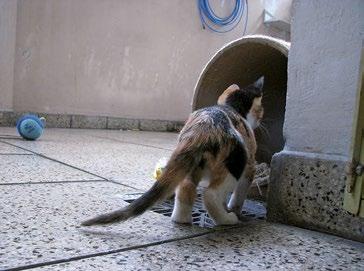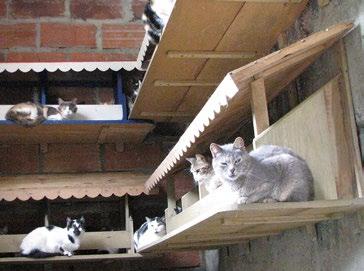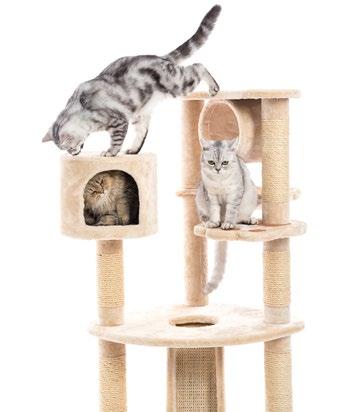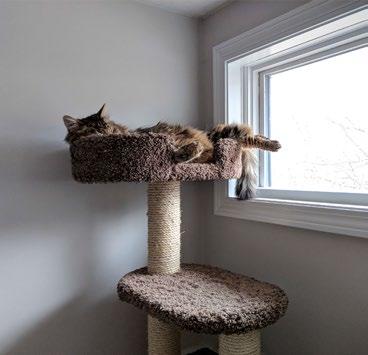
7 minute read
References
SERVET CLINICAL GUIDES AETIOLOGY
BEHAVIOURAL DISORDERS
18
FELINE PHEROMONES Feline pheromones are very useful in the treatment of all feline behavioural disorders, but particularly in those related to an impoverished environment, stress, or anxiety. Feline pheromones generate a feeling of wellbeing and calm in cats. The most effective devices are ambient diffusers. They release pheromones for approximately 1 month when plugged into an electrical wall socket. Only cats can smell feline pheromones – they are harmless and odourless for people and other animals.
ENVIRONMENTAL ENRICHMENT This approach aims to provide indoor cats with a stimulating and enriched environment that improves their lives. There is a range of options, as such the owner should be encouraged to consider different alternatives, depending on their lifestyle and type of home, to enrich their cat’s environment.
Enclosures that allow the animal to safely access outdoor areas make a great resource (Fig. 1). If outdoor access is limited or unavailable, owners must improve their pet’s indoor environment by providing entertainment and stimulation (Fig. 2).
In homes where several cats live together, they can be kept in cages from an early age to help define each cat’s individual territory. Kittens should
Figure 1. The use of enclosures will allow cats to access outdoor areas.

Figure 2. The indoor environment should be improved to provide the cat with entertainment and stimulation.
2 DISORDERS RELATED TO ENVIRONMENTAL STRESS. FELINE STEREOTYPIES
be familiarised with the setting by placing them in a cage large enough to cover all their needs (food, water, litter box, and sleeping area). They can also include toys or areas for climbing and hiding. When the owner is available to interact, the kitten should be let out of its cage to explore and play throughout the house and interact with the owner. Over time, the cage can be left open for increasingly longer periods until it remains open permanently, allowing the animal free access. As all of the cat’s needs can be fulfilled within the cage, it will regard the small area as its own territory.
Areas for climbing (Fig. 3) and relaxing on shelves (Fig. 4) also offer exercise and security, as they help maintain social order. Commercially available cat trees and furniture provide several areas for climbing and hiding (Fig. 5), as well as individual platforms; they also present extra benefits if they are placed close to a window (Fig. 6). When the owner does not have time to interact with the cat, they can use devices or toys that entertain the animal, for example, feathers hung in different locations. Environmental enrichment can sometimes include the acquisition of another animal. Obviously, each case requires a personalised study of the environmental conditions (owner’s lifestyle, cat’s habitat, time available, etc.).
Taking into account the owner’s lifestyle, the veterinarian should advise them on how to optimise their pet’s health and wellbeing. Lifestyle, environment, and diet should all be discussed during the first consultation. If the cat is given processed foods, they can be hidden in different locations to simulate hunting and gathering. This will entertain the cat and limit its intake better than a tray full of food.
Figure 3. Climbing area.


Figure 4. Wall shelving.
19
SERVET CLINICAL GUIDES AETIOLOGY
Figure 5. Cat furniture with climbing and hiding areas.


Figure 6. Cat furniture placed next to a window.
BEHAVIOURAL DISORDERS
20
DRUG TREATMENT
Stereotypies can be induced by drugs that activate the dopamine system (amphetamine and apomorphine); furthermore, endogenous opioid peptides released by the brain in stressful situations activate dopaminergic neurons, which means stereotyped behaviours respond favourably to opioid receptor blockers and dopamine antagonists.
Haloperidol inhibits stereotypies induced experimentally in cats with dopamine and dextroamphetamine.
SEROTONIN REUPTAKE INHIBITORS Stereotypies are generally treated with serotonin reuptake inhibitors as the first-line drug: fluoxetine, at a dose of 0.5–1.0 mg/kg/day, is the most effective, paroxetine is another option.
These drugs have some unwanted side effects such as gastrointestinal complaints (including anorexia and diarrhoea, although these can be mitigated by starting at a low dose and increasing up to the therapeutic dose), agitation, and insomnia.
2 DISORDERS RELATED TO ENVIRONMENTAL STRESS. FELINE STEREOTYPIES
Stereotyped behaviours are abnormal expressions of normal behaviours typically observed in the species, for example, grooming, vocalisation, locomotion, etc. The adverse effects of selective serotonin reuptake inhibitors are significantly milder than those associated with tricyclic antidepressants and much less unpredictable than the potential adverse effects of benzodiazepines.
TRICYCLIC ANTIDEPRESSANTS
The second most popular group of drugs are tricyclic antidepressants such as clomipramine (0.5–1.5 mg/day taken orally), imipramine (2.2–4.4 mg/kg/day), and amitriptyline (5–10 mg/day in two oral doses).
These drugs must be administered for at least 5 weeks and then for the least time possible thereafter because they all produce adverse side effects, including: ➤ Cardiovascular effects: orthostatic hypotension, decreased cardiac conduction, and antiarrhythmic properties. These do not represent a significant problem in healthy animals but vets should exercise utmost precaution when administering them to patients with partial heart block, as they may suffer complete heart block. ➤ Anticholinergic effects: these are the most common side effect, resulting from a block in muscarinic receptor activity. They include mydriasis, dry mouth, urinary retention, and constipation. ➤ Antihistamine effects. ➤ Sedative effects.
ANTICONVULSANTS
Anticonvulsants have a therapeutic purpose if the origin of the stereotypy was accurately diagnosed as subclinical epilepsy.
ANXIOLYTICS In most cases, patients with a stereotypy also exhibit a high degree of anxiety, so they are treated with anxiolytic agents. Benzodiazepines are the first-line anxiolytics, particularly clonazepam at a dose of 0.5–2.2 mg/cat/day taken orally, as its administration is more practical for the owner and it can be given in 1 or 2 daily doses, depending on each case.
The main disadvantage of benzodiazepines is the potential for addiction, so they must be discontinued gradually. There have been a few reports of idiopathic hepatic necrosis associated with the oral use of benzodiazepines, mainly diazepam. Additionally, administration of this drug group can reduce the effectiveness of behaviour modification techniques because they cause amnesia and therefore interfere with the patient’s learning capacity. Special attention must be paid when using diazepam in cats as it can occasionally produce a paradoxical effect.
21
SERVET CLINICAL GUIDES AETIOLOGY
Buspirone is also indicated for cats; it is a nonbenzodiazepine anxiolytic from the azaperone group. It modulates serotonin, by acting on pre- and postsynaptic serotonin 1A receptors, has practically no side effects, and can be discontinued quickly, unlike benzodiazepine derivatives. However, buspirone does not have such a potent therapeutic action as the aforementioned drugs, but it has given good results when combined with behaviour modification techniques and can be used safely in cats. The dose given to cats is 2.5–5.0 mg/cat/day, spread across two doses.
It is totally contraindicated to punish the animal when it exhibits the stereotypy or stop it from carrying out the action.
BEHAVIOURAL DISORDERS
22
Steps to follow 1. The owner must avoid reinforcing the behaviour. 2. Instruct the owner to distract the cat from its compulsive behaviour by attracting its attention with noises, a new object to investigate, etc. Never use reinforcements (e.g. food) to get the cat’s attention. 3. Encourage the owner to enrich the cat’s environment. 4. Use drug treatment; psychoactive agents form an important part of the overall treatment plan for this type of behavioural disorders.
The publishing strength of Grupo Asís
Editorial Servet, a division of Grupo Asís, has become one of the reference publishing companies in the veterinary sector worldwide. More than 15 years of experience in the publishing of contents about veterinary medicine guarantees the quality of its work. With a wide national and international distribution, the books in its catalogue are present in many different countries and have been translated into nine languages to date: English, French, Portuguese, German, Italian, Turkish, Japanese, Russian and Chinese.
Its identifying characteristic is a large multidisciplinary team formed by doctors and graduates in Veterinary Medicine and Fine Arts, and specialised designers with a great knowledge of the sector in which they work. Every book is subject to thorough technical and linguistic reviews and analyses, which allow the creation of works with a unique design and excellent contents.

Servet works with the most renowned national and international authors to include the topics most demanded by veterinary surgeons in its catalogue. In addition to its own works, Servet also prepares books for companies and the main multinational companies in the sector are among its clients.
Communication services
Online visualisation of the sample chapter. Presentation brochure in PDF format, compatible with mobile devices.

Servet (División de Grupo Asís Biomedia S.L.) Centro Empresarial El Trovador, planta 8, oficina I
Plaza Antonio Beltrán Martínez, 1 • 50002 Zaragoza (España) Tel.: +34 976 461 480 • Fax: +34 976 423 000 • www.grupoasis.com


